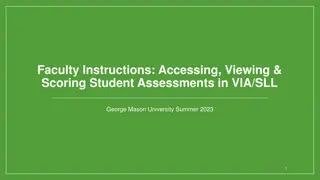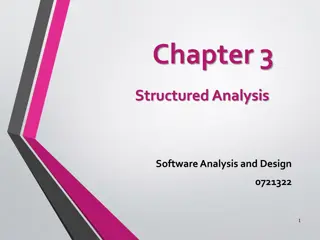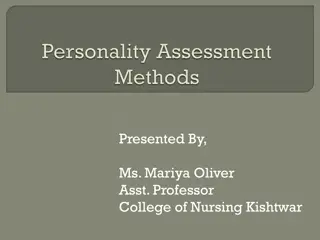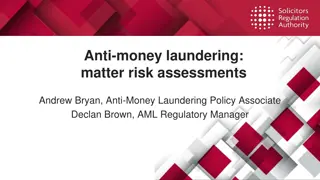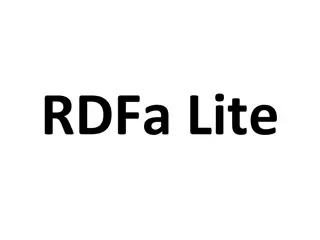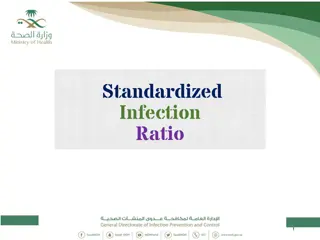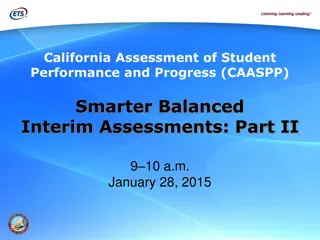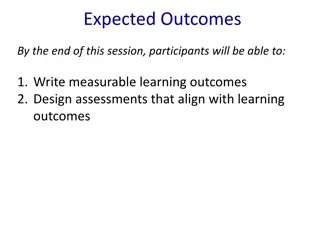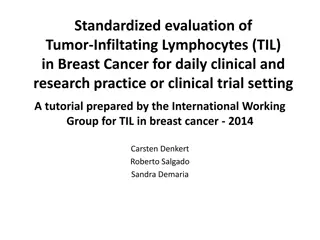Understanding Structured and Standardized Assessments in Education
Explore the world of structured and standardized assessments with a focus on their role, purpose, and administration. Learn about important factors in selecting measures, interpreting results, and evaluating validity and reliability. Discover the benefits and advantages of standardized measures in educational settings.
Download Presentation

Please find below an Image/Link to download the presentation.
The content on the website is provided AS IS for your information and personal use only. It may not be sold, licensed, or shared on other websites without obtaining consent from the author. Download presentation by click this link. If you encounter any issues during the download, it is possible that the publisher has removed the file from their server.
E N D
Presentation Transcript
Structured and Standardized Assessments Blake Beecher Eastern Washington University
Learning Objectives: 1. Increase knowledge about the role and purpose of structured assessments 2. Increase knowledge how to address findings of structured assessments 3. Become familiar with frequently used structured assessment tools 4. Become competent in administering, interpreting, and scoring above assessments 5. Demonstrate ability to administer, interpret, and utilize an assessment in demonstration with peer
What is a standardized measure? Measures designed in such a way that the questions, conditions for administering, scoring procedures, and interpretations are consistent and are administered and scored in a predetermined, standard manner. Vary in what they measure; type; perspective of user Uniform procedures for scoring & administrating a test Enough info to judge whether test is appropriate for your situation
Factors in Selecting Measures Easy Quick Not expensive Non-offensive (non intrusive) Supported by research Is applicable to your setting Gives you beneficial information
Purpose What is the problem being measured? Substance Abuse? Depression? Cognition? How sensitive or appropriate is the measure? What is the benefit of using this measure?
Interpretation Clearly stated (clinical cut-offs) Enough information Do you understand how to use and interpret the assessment tool?
Validity Does the measure actually measure the presenting issue? Does it measure what it s supposed to? Does the measure reflect the range of the severity problem? Does it increase if expected?
Reliability How consistent, stable or dependable is the measure? Would repeated testing yield the same result?
Advantages of Standardized Measures Efficiency Accessibility Comparability Neutrality Evaluation friendly
Disadvantages Psychometric problems, norms Limits of what the test measures Practical problems Agency problems Ethical problems
Administration Ask permission Be clear on objectives of test, how it will be used Would you rather I read it to you? Stress importance of accurate responses Home, office, waiting room? How often?
Common Assessments which may be used in Integrated Healthcare DSM Diagnosis Mental Status Exam Depression (PHQ9) Bipolar (MDQ) SAFE-T suicide screen Trauma Screen (PC-PTSD) Substance Abuse (CAGE aid) Mini Mental State (brief cognitive screen) Pediatric Symptom Checklist Activities of Daily Living (Katz)
Diagnostic and Statistical Manual of Mental Disorders To provide clear descriptions of diagnostic categories in order to enable clinicians and investigator to diagnose, communicate about, study, and treat people with various mental disorders
International Classification of Disease (ICD-10) Comprehensive classification system of medical conditions and mental disorders Official medical and psychiatric classification of diseases used throughout most of the world
ICD-10 VS DSM-IV-TR Both are the classification systems and fully compatible, although the wording may differ. All of the DSM-IV-TR categories are found in ICD-10 but not all ICD categories are found in DSM-IV.
Multiaxial System Axis I: Psychiatric Diagnoses Axis II: Personality Disorders Mental Retardation Axis III: Medical Diagnosis Axis IV: Psychological and Environmental Stressors Axis V: The Global Assessment of Functioning (GAF)
Axis I: Clinical Disorders1 Anxiety Disorders Mood Disorders Substance-related Disorders Schizophrenia and Other Psychotic Disorders Delirium, Dementia, and Amnestic and other Cognitive Disorders Mental Disorders Due to a General Medical Condition Eating Disorders Adjustment Disorders
Axis I: Clinical Disorders2 Somatoform Disorders Factitious Disorders Dissociative Disorders Sexual and Gender Identity Disorders Eating Disorders Sleeping Disorders Impulse-Control Disorders Adjustment Disorders
Axis II: Personality Disorders3 Paranoid Personality Disorder Schizoid Personality Disorder Schizotypal Personality Disorder Antisocial Personality Disorder Borderline Personality Disorder Histrionic Personality Disorder Narcissistic Personality Disorder Avoidant Personality Disorder Dependent Personality Disorder Obsessive-Compulsive Personality Disorder Personality Disorder not Otherwise Specified Mental Retardation Cluster A: Odd, Eccentric Cluster B: Emotional, dramatic, erratic Cluster C: Anxious, fearful
Axis III: General Medical Condition Infection and parasitic disease (001-139) Neoplasms (140-239) Endocrine, nutritional, and metabolic disease and immunity disorders (240-279) Disease of the blood and blood-forming organs (280-289) Disease of the nervous system and sense organs (320-389) Source: DSM-IV, P28
Common Medical Conditions (Axis III) in Integrated Healthcare Obesity Diabetes Hypertension Heart Disease Arthritis Injuries Respiratory Diseases (many related to smoking)
Axis IV: Psychosocial and Environmental Problems Problems with Primary Support Group Problems Related to the Social Environment Educational Problems Occupational Problems Housing Problems , Economic Problems Problems with Access to Health Services Problems Related to Interaction with the Legal System Other Psychological and Environmental Problems
AXIS V: Global Assessment of Functioning Reports the clinician s view of the client s overall level of functioning at the time of the interview. Uses a global assessment of functioning scale (GAF) that ranges from a score of 100 (high) to 1 (low). It is reported as (e.g.) GAF=65.
Axis V: Global Assessment of Functioning Scale 100-91: Superior functioning, no symptoms 90-81: Absent or minimal symptoms, good functioning in all area 80-71: Transient and expectable reactions to psycho social stressors 70-61: Some mild symptoms, some difficulty in social, occupational, or school functioning
Axis V: GAF Scale 60-51: Moderate symptoms, moderate difficulty in social , occupational, or school functioning 50-41: Serious symptoms, serious impairment in social, occupational, or school functioning 40-31: Some impairment in reality testing or communication or major impairment in several areas-work, school, family relations, judgment, thinking or mood
Axis V: GAF Scale (Contd) 30-21: Behavior is considerably influenced by delusions or hallucinations or serious impairment in communication or judgment 20-11: Some danger of hurting self or others, or gross impairment in communication 10-1: Persistent danger of severely hurting self or others, or serious suicidal act with 0: Inadequate information
Multiaxial Diagnostic Schema Example Axis I: Major Depression Disorder Alcohol Abuse Axis II: No Diagnosis Axis III: Hypertension, Diabetes Axis IV: Social Isolation, unemployed, housing problems, Axis V: GAF=40 (current)
ADDRESSING Guideline to Assess for Client Cultural Influences4 A ge and generational influences D isability status (developmental disability) D isability status (acquired physical/ cognitive/psychological disabilities) R eligion and spiritual orientation E thnicity S ocioeconomic status S exual orientation I ndigenous heritage N ational origin G ender
Activity Break into groups of 3 to practice one or more of the structured instruments covered. 1 SWer, 1 client, and 1 observer. Have the student client play the role of a client they are familiar with. After 5-7 minute interaction, stop, all members discuss for 2-3 minutes, then rotate.
References 1. American Psychiatric Association. (2000). Diagnostic and statistical manual of mental disorders (4th ed., text rev.). Washington, DC: Author. (p. 26) 2. American Psychiatric Association. (2000). Diagnostic and statistical manual of mental disorders (4th ed., text rev.). Washington, DC: Author. (p. 26) 3. American Psychiatric Association. (2000). Diagnostic and statistical manual of mental disorders (4th ed., text rev.). Washington, DC: Author. (p. 27) 4. Hays, P.A. (1996). Addressing the complexities of culture and gender in counseling. Journal of Counseling and Development, 74, 332-338.



